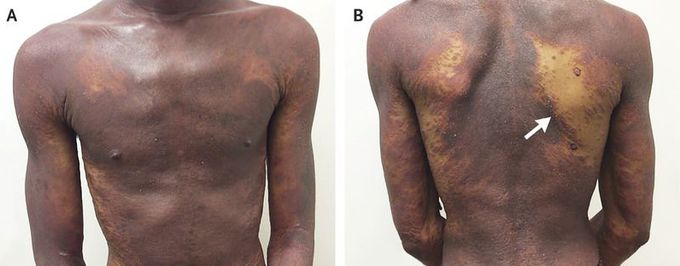


Erythrodermic Psoriasis and HIV Infection
A 29-year-old man presented to the dermatology clinic with a pruritic, erythematous, and scaly rash that had first appeared 2 years earlier. He had sought no medical treatment until this presentation. His medical history included eczema during childhood and seasonal allergies. He was taking no medications. A physical examination showed erythematous, violaceous plaques (Panel A) that involved more than 90% of the patient’s body-surface area, with some areas (for example, on the back) that were spared and reflect the baseline appearance of the patient’s skin (arrow, Panel B). The differential diagnosis for generalized erythema and plaque formation includes erythrodermic psoriasis, seborrheic dermatitis, and pityriasis rubra pilaris. A punch biopsy specimen obtained from two areas on the back confirmed the diagnosis of erythrodermic psoriasis. An erythrodermic papulosquamous eruption can be associated with an underlying systemic disease. In this case, testing for human immunodeficiency virus (HIV) infection was positive. The patient received highly active antiretroviral therapy as well as topical triamcinolone. At a follow-up visit 3 months later, the patient had complete clearance of the skin eruption with some residual hyperpigmentation.
Living with HIV was one of the hardest experiences of my life. The fatigue, the emotional toll, and the uncertainty about the future weighed on me every single day. I had tried many treatments and medications, but nothing seemed to restore my health or energy the way I hoped.Out of both hope and desperation, I came across NaturePath Herbal Clinic. At first, I was skeptical but something about their natural approach and the powerful stories I read gave me the courage to try one more time.I began their herbal treatment program, and within a few weeks, I noticed small but meaningful changes more energy, better sleep, and a stronger immune system. Over the months, those improvements only grew. Today, I can truly say my life has changed. I feel healthier, more balanced, and finally in control of my well-being again.This isn’t just a testimony it’s a heartfelt recommendation to anyone living with HIV or any chronic condition. Don’t give up hope. I’m so grateful I gave NaturePath Herbal Clinic a chance. Visit their website to learn more: www.naturepathherbalclinic.com Email: info@naturepathherbalclinic.com


